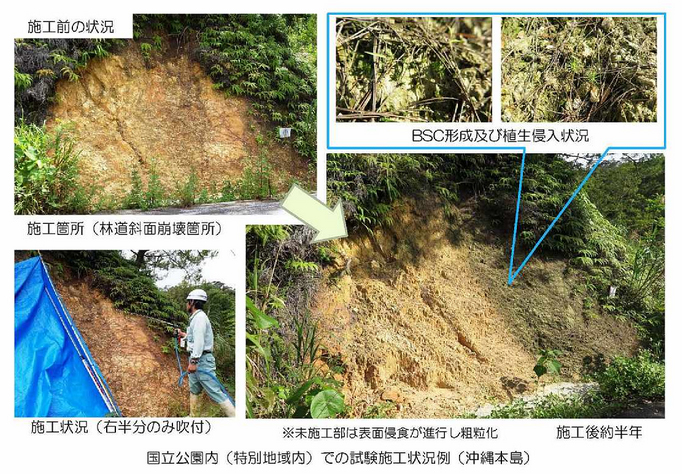Updated by "Forest Circular Economy" Editorial Board on May 08, 2025, 12:47 PM JST
Editorial Board, Forest Circular Economy
Forestcircularity-editor
We aim to realize "Vision 2050: Japan Shines, Forest Circular Economy" promoted by the Platinum Forest Industry Initiative. We will disseminate ideas and initiatives to promote biomass chemistry, realize woody and lumbery communities, and encourage innovation in the forestry industry in order to fully utilize forest resources to decarbonize the economy, strengthen economic security, and create local communities.
The Biological Soil Crust (BSC) method, which is being jointly developed by Tokyo University of Agriculture, Nihon Koei, and Nikken Corporation, has been selected as a "Recommended Technology for 2025" by the Ministry of Land, Infrastructure, Transport and Tourism's New Technology Information System (NETIS). This method is a nature restoration technology that uses microalgae to control soil erosion on bare land and collapsed slopes and encourages the spontaneous growth of plants.
BSC refers to microbial communities, such as microalgae, that form on the soil surface. When a development material made mainly from microalgae is sprayed on a soil collapse site, the microalgae settle in the soil and form a BSC, thereby increasing the viability of plant seeds. Soil algae are cosmopolitan, distributed throughout the world, and they reproduce asexually, which means that genetic disturbance does not occur.
The BSC method creates an environment where plants and trees can easily take root, effectively preventing soil runoff caused by rainfall and wind. It is expected to be applied to disaster restoration, bare land after forest road construction, and steep slopes where revegetation is difficult.

Materials made of man-made materials have been sprayed on collapsed slopes and rough/glossy surfaces caused by construction work in the past; the use of the BSC method allows soil algae cover to be formed quickly on bare ground, etc., which takes time under natural conditions, preventing soil erosion and promoting natural encroachment of vegetation.
NETIS is a database maintained and operated by the Ministry of Land, Infrastructure, Transport and Tourism to promote the use of new technologies in public works projects. There has never been an example of using soil algae as a civil engineering material, and the BSC method was highly evaluated for its versatility, its applicability to various locations while taking the local ecosystem into consideration, and its ease and low cost of implementation. As a result of its selection as a recommended technology, the BSC construction method will receive preferential treatment, such as points for public works projects. It is expected to become an option for slope disaster prevention, forest infrastructure development, and regional environmental restoration.
In order to implement the BSC method in society, Nikken Sohn succeeded in cultivating algae growing on the soil surface underwater and transforming them into civil engineering materials. The algae cultivated underwater and converted into civil engineering materials were used in the erosion prevention method jointly developed by the National Research Institute of Public Works and Nippon Koei. Tokyo University of Agriculture contributed to the establishment of evidence and testing of these technologies.

The BSC method is a revolutionary technology in that it is expected to be more environmentally friendly and sustainable than conventional soil stabilization and revegetation materials.
In particular, it has the potential to contribute as a new, environmentally friendly solution to social issues such as the frequent occurrence of heavy rainfall disasters due to climate change in recent years and the promotion of national land resilience. The practical application and dissemination of this new conservation technology in mountainous areas that are not well cared for, and in areas that are being devastated by climate change, is attracting attention.
BSC method to prevent soil erosion and promote natural penetration of vegetation